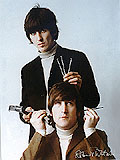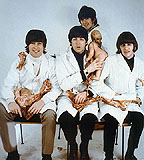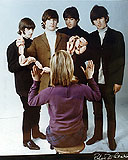
 Fixing a Hole |
 Yesterday & Today |
 Umbilical Cord |


Although English by birth, it was in Melbourne that Robert Whitaker first met the Beatles, on their 1964 Australian tour. He had come to Melbourne in 1961 and was working as a freelance photographer, with studios in Flinders Lane, when he photographed Beatles' manager, Brian Epstein, for an article for the Jewish News. " I photographed Epstein, saw he was a bit of a peacock and a cavalier, and put peacock feathers around his head in photographic relief ", Whitaker recalls. " He was knocked out when he saw the picture. After that, he saw an exhibition of collages I had at the Museum of Modern Art and immediately offered me the position of staff photographer at NEMS, photographing all his artists. I initially turned it down, but after seeing the Beatles perform at Festival Hall I was overwhelmed by all the screaming fans and I decided to accept the offer to return to England ".
Art historian, David Mellor, believes that Whitaker's three-year absence from London had transformed him as a photographer. In Australia Whitaker, through his connection with Georges and Mirka Mora, had mixed with senior artists Arthur Boyd, John Percival and Charles Blackman, as well as his own peer group, Martin Sharp, Richard Neville, Barry Humphries and Germaine Greer. " Bob setting to work with the Beatles was a real breakthrough ", Martin Sharp recalls. " When Richard Neville and I left for England, Bob was on the TOP or my list of people to contact, ". (Whitaker and Sharp were to collaborate on the cover of the Cream's Disraeli Gears album, as well as the first few issues of Oz Magazine, with Richard Neville.)
On his arrival back in England in August 1964, Whitaker went to work photographing the likes of Billy J. Kramer, Gerry and the Pacemakers and Cilia Black, but it was with the Beatles that he produced his most creative work. He became especially friendly with John Lennon and, in one 1965 picture, represented Lennon with a dandelion sprouting from one eye and as Narcissus, enchanted by his own reflection. In this image Whitaker reflected his own indebtedness to the surrealist, Salvador Dali.
And so it was to Surrealism that Whitaker turned once again for inspiration for his most famous shot. Meret Oppenheim's, Lunch In Fur, a cup and saucer and spoon made out of fur, provided the inspiration for the notorious " Butcher's Sleeve ". " It's an apparent switch-around of how you think ", Whitaker says. " Can you Imagine actually drinking out of a fur tea cup ? I did a photograph of the Beatles covered in raw meat, dolls and false teeth. Putting meat, dolls and false teeth with tne Beafles is essentially part of the same thing, the breakdown cf what is regarded as normal. The actual conception for what I still call " Somnambulant Adventure " was Moses coming down from Mt. Sinai with the 10 Commandments. He comes across people worshipping a golden calf. All over the world I'd watched people worshipping like idols, like gods, four Beatles, To me they were just stock standard normal people. But this emotion that fans poured on them made me wonder where Christianity was heading ".
"Having finished that particular picture, it was snatched away from me and sent off to America. It was reproduced as a record cover without ever having the artwork completed by me. The cover layout was somebody else's conception. It was a good idea to ban it at the time, because it made no sense at all. It was just this rather horrific image of four Beatles, whom everybody loved, covered in raw meat, the arms, legs and torsos of dolls, and false teeth. But they are only objects placed on the Beatles, rather like making a movie. I mean what you want to read into it is entirely up to you. I was trying to show that the Beatles were flesh and blood ", he states.
Whitaker remembers that when the album, Yesterday and Today, was first distributed to the various radio stations " there was a fairly large outcry from DJs who were saying we're almost retching with disgust from this picture. I repeat that the cover was an unfinished concept. It was just one of a series of photographs that would have made up a gate-fold cover. Behind the head of each Beatle would have been a golden halo and in the halo would have been placed a semi-precious stone. Then the background would have contained more gold, so it was rather like a Russian icon. It was just after John Lennon had said that the Beatles were more popular than Jesus Christ. In a material world that was an extremely true statement, " he comments.
Whitaker's " stolen " photograph was first published on the cover of Disc, in June 1966, with the headline, " Beatles: What a Carve-up ", before the decision was taken to use it on the album sleeve. Philip Norman, in his book, Shout claims that Brian Epstein had " misgivings " about the picture, claiming it would disrupt his carefully codified image of the Beatles, but the band overruled him. According to John Lennon, the " Butcher's Cover " was inspired by " our boredom and resentment at having to do another photo session and another Beatles' thing. We were sick to death of it. Bob (Whitaker) was into Dali and making surreal pictures. That combination produced the cover ".
Whitaker remembers that " John played with all sorts of bits and pieces before we actually did the picture. 1 did a few outtake pictures which were of them actually playing with a box full of dolls which they pulled out and stuck all over themselves. There was an enormous amount of laughter. There was even George Harrison banging nails into John's head with a hammer. The actual conception of what is termed the " Butcher's Sleeve " is a reasonably diverse piece of thinking, " he boasts, adding that it was something Lennon was talking about right up to his death in 1980. Asked whether it was a gratuitous image at the time it was banned, Lennon had replied that it was " as relevant as Vietnam. "
The Beatles' American albums on Capitol were not simply duplicates of EMI's English releases. They were collections of material culled from the Beatles' previously-released British albums, selected and packaged by Capitol specially for the American market. Yesterday and Today included songs from the Help! and Rubber Soul LP's, plus. unusually, four songs from Revolver, which was not be released in Britain for another three weeks. And, as Philip Norman points out, any promise of gentle nostalgia, contained in the title of this hybrid. Yesterday and Today was quickly dispelled by the full-cover sleeve on which the Beatles, " wearing white butchers' overalls, nursed dismembered and decapitated toy dolls and brandished bloody bits of meat ".
There are varying estimates as to how many copies of the album sleeve wore printed and distributed, In a recent conversation with me, Whitaker put the number at 250,000. Other sources range from as high as 750,000 to as low as 6,000. But what is certain is that, once the complaints began Capitol Records reacted swiftly and, in a single weekend, all copies of the album still available (it is estimated that 25,000 copies were sold retail) and all promotional material featuring the butcher photo were recalled. A specially convened staff spent the weekend taking each disc from the " butcher sleeve " and placing it in the new sleeve. In the official letter of recall, dated June 14th, 1966, Alan W. Livingston, President of Capitol Records, is quoted as saying:
" The original cover, created in England, was intended as a `pop art' satire. However a sampling of public opinion in the United States indicates that the cover design is subject to misinterpretation. For this reason, and to avoid any possible controversy or undeserved harm to the Beatles' image or reputation, Capitol has chosen to withdraw the LP and substitute a more generally acceptable design. "
The offending photo was replaced by a seemingly innocent shot of the Beatles in a hotel room, gathered around a cabin trunk. Several thousand of the butcher covers were destroyed and replaced by the cabin trunk, but, in the long run, Capitol decided that it was far more economical to simply paste the new cover photo over the old one. Once that news got out, Beatle fans across America could be found beavering away in their kitchens steaming cabin trunk photos off of their copies of Yesterday and Today in the hope of finding the original, rare butcher cover underneath.
Many collectors believe that the butcher cover is still one of the most sought-after pieces of Beatle memorabilia. Brendan Pearse, former owner of the Beatles' Shop in Melbourne, agrees- " The best thing I've ever sold is an unpeeled butcher cover ", he says. It's not the greatest price I've ever sold anything for. It was just the fact that it was a brand new unpeeled butcher cover that had been sitting in a record shop for 25 years. It was in pristine condition. The actual record had not been played. We sold that for $2000 to Japan. According to Harrison, " it is the definitive Beatles' collectible. " And Whitaker himself relates the story of the woman who came up to him with an unpeeled cover in the US, had him autograph it, and promptly sold it for US$40,000.
In 1991, after almost 20 years in " retirement ", farming in Sussex, Whitaker triumphantly exhumed some of his previously unpublished photographs of the Beatles for his book, simply titled The Unseen Beatles. And a touring exhibition of his photographs from the 1 960s, Underground London, which includes photographs of the individual Beatles as well as shots from the " Butcher's Sleeve " session, will commence at The National Gallery of Victoria this month, before heading to America for a two-year tour there.
All the while his ongoing battle with Apple Corps as to who owns the rights to the " Butcher's Sleeve " picture remains unresolved. Apple Corps have attempted to " censor " the picture, telling Whitaker they do not want the image reproduced as a book cover, postcard, poster, " virtually in no form whatsoever, " he says. Whitaker was so incensed with Apple Corps that, at one stage, he considered making an enormous print of the " Butcher's Sleeve " for his Underground London exhibition and putting it behind closed doors so that people would have to file in one at a time. " One story I heard from the record company was that the dolls in the picture could upset the paedophiles, " he laughs. Whitaker is currently working with Peter Blake (designer of the Sgt Pepper sleeve) on a fuIl~scaIe recreation of his idea for " Somnambulant Adventure ", to be exhibited in London next year.
Apple Corps have now established their own photo library from which they oversee distribution of copyright Beatle material around the world. According to Derek Taylor, Apple Corps' long-serving press boss, " the person who might know who has the actual copyright to the " Butcher's Sleeve " picture is not yet born " Taylor was once described as encouraging a " kind of benevolent anarchy to develop " at Apple when it first started, and it seems that this stilt may be the case. Acknowledging that Whitaker was employed by Epstein at the time he took the picture, which he feels gives Apple the legal copyright, Taylor recognises that it was Whitaker " who took the picture, who thought of the idea, and that would give him a proprietary moral right. " Taylor adds that although he has never personally enjoyed the picture " it has its place in history for it is part of the (Beatles) story. As a piece of Beatles' art it has its place on the wall, " he laughs. Interestingly, E.M.I. released a picture-disc single of Paperback Writer / Rain in 1985 with THAT photograph as the picture on the disc-
Taylor is less adamant than Whitaker that all the Beatles enjoyed taking part in the session, stating that " George still doesn't like it. " (Harrison, incidentally, is a Director of Apple Corps, and a vegetarian). But Taylor still believes that things went to far with the banning of the cover and finds its replacement less innocuous than it seems. " I mean which is worse, Beatles with meat all over them, or four Beatles in a trunk in a hotel room. If you really think about it what would they be doing in a trunk "? Whitaker agrees. " I made that dumb ass photo of the Beatles with the trunk in Brian Epsteinís office when we were all in Argyll Street, next door to the London Palladium. Derek is right. It was far more stupid than anything else I could think of. The trunk was to hand in the office, so I thought that by putting the light meter in the picture it might convey an idea of the speed of light running so fast that it shot straight back up your " arse ". It was just to see what could become a record cover ".
In three short years, between 1964 and 1966, Robert Whitaker managed to compile an remarkable photographic dossier on the 20th century's most astounding musical phenomenon. His Unseen Beatles offers an extraordinarily personalised insider's view of a very private world, while many more negatives await retrieval from his Sussex barn. And, for a time it seemed that even his battle with Apple Corps might have ended, with Managing Director, Neil Aspinall, negotiating with him over use of 300 of his images of the Beatles in the recent television documentary, Anthology " On one day Neil Aspinall is offering me 80,000 pounds for the use of my pictures in his Anthology of the Beatles, chatting about their past around the table of an English pub, " Whitaker asserts, " The next day Aspinall phones to say that he thinks I should give the Anthology all the pictures for nothing, having spent six months deciding which images should be reprinted, retouched and repaired. We the Beatles own Whitaker's life. Needless to say, they got nothing, " he concludes wryly. Now, hot on the heels of the success of Underground London, the " one part Aussie lad ", as Whitaker calls himself (according to Whitaker, his grandfather built Princes Bridge in Melbourne), is about to start work on his own series of CD Roms of his photographs of the 1980's, including almost every image he took of the Beatles.
Robert Whitaker's exhibition, Underground London, at the National Gallery of Victoria from December 11 to January 27, provides a rare insight into a life that most of us could have only dreamed about.. As Whitaker himself has stated, " there were about 100 people who ran the Sixties ". He was lucky enough to meet and photograph them all. The intimacy that he extracted from his subjects is staggering. During the second half of the 1960s, Whitaker thrived at the core of London underground culture, where he worked with such figures as Eric Clapton (and the Cream), Germaine Greer and Martin Sharp (on Oz Magazine) and Mick Jagger (on the film sets of Pefformanco and Ned Kelly) Looking for further challenges, he covered major world events for Time and Life Magazines, including the Florence floods and the wars in Cambodia and Vietnam. Underground London is a unique opportunity to share the Swinging Sixties with someone whose vision went some way to exploring the political undercurrents of the time.
Roger Taylor
November, 1998.
Roger Taylor is a Melbourne-based writer and broadcaster. His radio program, High & Low. is broadcast weekly on 3RRR-FM, Wednesdays at 1.00 PM. he is an editorial correspondent for World Art and has published widely in magazines such as Asian Art News, Asia-Pacific Sculpture News and Art New Zealand.
Images:
1. " Fixing a Hole " 1966
2. " Yesterday & Today " 1966
3. " Umbilical Cord " 1966
Copyright © Robert Whitaker - These images remain the property of the Photographer.
These images are not to be downloaded, used or displayed in public without express permission.

![[Button]](../../images/black.jpg)
![[Button]](../../images/white.jpg)


